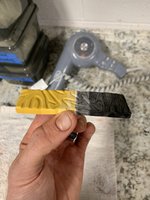mwar15
Omono
For those pot heads…..
i’ve really started enjoying using iron oxide for my pots. I discovered a 5 gallon bucket literally of yellow iron oxide and black iron oxide powder at the studio.
Has anyone use these as a coating? If so any ratio powder to water with examples?
This is just a rough recipe I whipped up on a test tile. I Think it’s a quarter teaspoon of powder to probably 3 tablespoons water, then brushed on. 1-4 coats

i’ve really started enjoying using iron oxide for my pots. I discovered a 5 gallon bucket literally of yellow iron oxide and black iron oxide powder at the studio.
Has anyone use these as a coating? If so any ratio powder to water with examples?
This is just a rough recipe I whipped up on a test tile. I Think it’s a quarter teaspoon of powder to probably 3 tablespoons water, then brushed on. 1-4 coats



